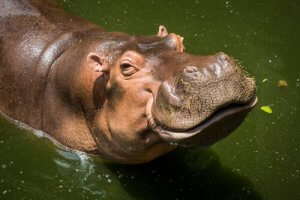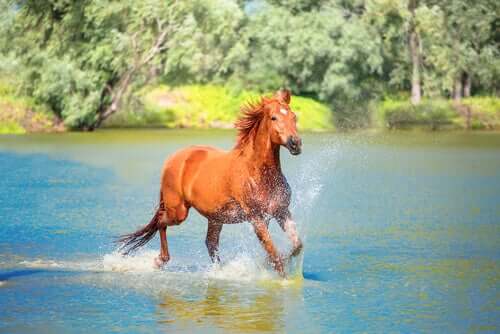How Do Animals Sweat?

Many animals have different secretion systems to humans. In this article, we’ll tell you how animals sweat. Interesting stuff!
Why do animals sweat?
First, we need to understand why animal sweat. Sweat is a liquid secreted by the sweat glands that cool the body. Species that sweat are called ‘homeotherms’, which means that their metabolism generates heat when the main organs work.
This doesn’t happen with cold-blooded animals such as reptiles and amphibians. Therefore, unlike mammals, they don’t have a thermoregulatory system. Sweating also helps the body to get rid of the build-up of waste substances and salt.

Therefore, only animals that have sweat glands can sweat. All other animals have other methods for regulating body temperature.
For example, rabbits and rodents are examples of mammals that are the exception to the rule and don’t sweat. They lose heat through their tails and ears instead. This is why desert subspecies have bigger ears than their forest or field relatives.
A well-known case is dogs. They use panting to remove excessive body heat through evaporation of water from the tongue, whereas pigs wallow in mud or water to cool down.
Different variations of sweating
Depending on the species of animal, it will have different ways of eliminating sweat. It all depends on the glands it has. For example, amphibians have very sensitive and light skin that, instead of producing ‘sweat’, have glands that secrete moisturizing mucus or poison depending on the situation.
Reptiles have thicker skin, which is protected by a layer of keratin, but they don’t have glands. On the other hand, birds use their uropygial glands to produce a kind of oil that allows them to preen and waterproof their feathers.
The vast majority of mammals sweat, but not all in the same way. It all depends on the sweat glands found on their skin. There are two types:
1. Eccrine
These are the ones that humans and primates have and are found all over their bodies. Sweat is shed on the surface of the skin, especially the armpits, hands, feet, forehead, and neck.
2. Apocrine
These glands are present in some parts of the skin, such as the palms of the hands, soles of the feet, the nose or uncovered areas of hair. Certain species such as the donkey, camel or cow also have these glands almost all over their body, which allows them to cool down when it’s very hot.
How different animals sweat
In addition to the species listed above, the following animals have unusual sweating techniques that are worth talking about:
1. Horses
Horses sweat mainly through their bellies and their necks. When horses exercise and run long distances, sweat turns into a kind of foam on the skin. After one hour of strenuous exercise, a horse can lose up to 33 fluid ounces of sweat.
 2. Hippos
2. Hippos
This huge mammal has a special pinkish secretion to protect it from the sun on certain parts of its skin, because it’s thin and delicate. Hippos mainly excrete this liquid to maintain hydration and avoid infections.
3. Birds
Birds sweat very little to the point where it’s practically unnoticeable. They sweat from the areas that aren’t covered by feathers, like under the wing (you could call this their armpit). Then they open their wings to dry out and to avoid fungus or infection. They’re really smart!
4. Cats
Cats sweat through the pads on their paws and from their nose. There are exceptions such as the hairless sphinx cat that needs to secrete fat to protect it from the sun.
Many animals have different secretion systems to humans. In this article, we’ll tell you how animals sweat. Interesting stuff!
Why do animals sweat?
First, we need to understand why animal sweat. Sweat is a liquid secreted by the sweat glands that cool the body. Species that sweat are called ‘homeotherms’, which means that their metabolism generates heat when the main organs work.
This doesn’t happen with cold-blooded animals such as reptiles and amphibians. Therefore, unlike mammals, they don’t have a thermoregulatory system. Sweating also helps the body to get rid of the build-up of waste substances and salt.

Therefore, only animals that have sweat glands can sweat. All other animals have other methods for regulating body temperature.
For example, rabbits and rodents are examples of mammals that are the exception to the rule and don’t sweat. They lose heat through their tails and ears instead. This is why desert subspecies have bigger ears than their forest or field relatives.
A well-known case is dogs. They use panting to remove excessive body heat through evaporation of water from the tongue, whereas pigs wallow in mud or water to cool down.
Different variations of sweating
Depending on the species of animal, it will have different ways of eliminating sweat. It all depends on the glands it has. For example, amphibians have very sensitive and light skin that, instead of producing ‘sweat’, have glands that secrete moisturizing mucus or poison depending on the situation.
Reptiles have thicker skin, which is protected by a layer of keratin, but they don’t have glands. On the other hand, birds use their uropygial glands to produce a kind of oil that allows them to preen and waterproof their feathers.
The vast majority of mammals sweat, but not all in the same way. It all depends on the sweat glands found on their skin. There are two types:
1. Eccrine
These are the ones that humans and primates have and are found all over their bodies. Sweat is shed on the surface of the skin, especially the armpits, hands, feet, forehead, and neck.
2. Apocrine
These glands are present in some parts of the skin, such as the palms of the hands, soles of the feet, the nose or uncovered areas of hair. Certain species such as the donkey, camel or cow also have these glands almost all over their body, which allows them to cool down when it’s very hot.
How different animals sweat
In addition to the species listed above, the following animals have unusual sweating techniques that are worth talking about:
1. Horses
Horses sweat mainly through their bellies and their necks. When horses exercise and run long distances, sweat turns into a kind of foam on the skin. After one hour of strenuous exercise, a horse can lose up to 33 fluid ounces of sweat.
 2. Hippos
2. Hippos
This huge mammal has a special pinkish secretion to protect it from the sun on certain parts of its skin, because it’s thin and delicate. Hippos mainly excrete this liquid to maintain hydration and avoid infections.
3. Birds
Birds sweat very little to the point where it’s practically unnoticeable. They sweat from the areas that aren’t covered by feathers, like under the wing (you could call this their armpit). Then they open their wings to dry out and to avoid fungus or infection. They’re really smart!
4. Cats
Cats sweat through the pads on their paws and from their nose. There are exceptions such as the hairless sphinx cat that needs to secrete fat to protect it from the sun.
This text is provided for informational purposes only and does not replace consultation with a professional. If in doubt, consult your specialist.








